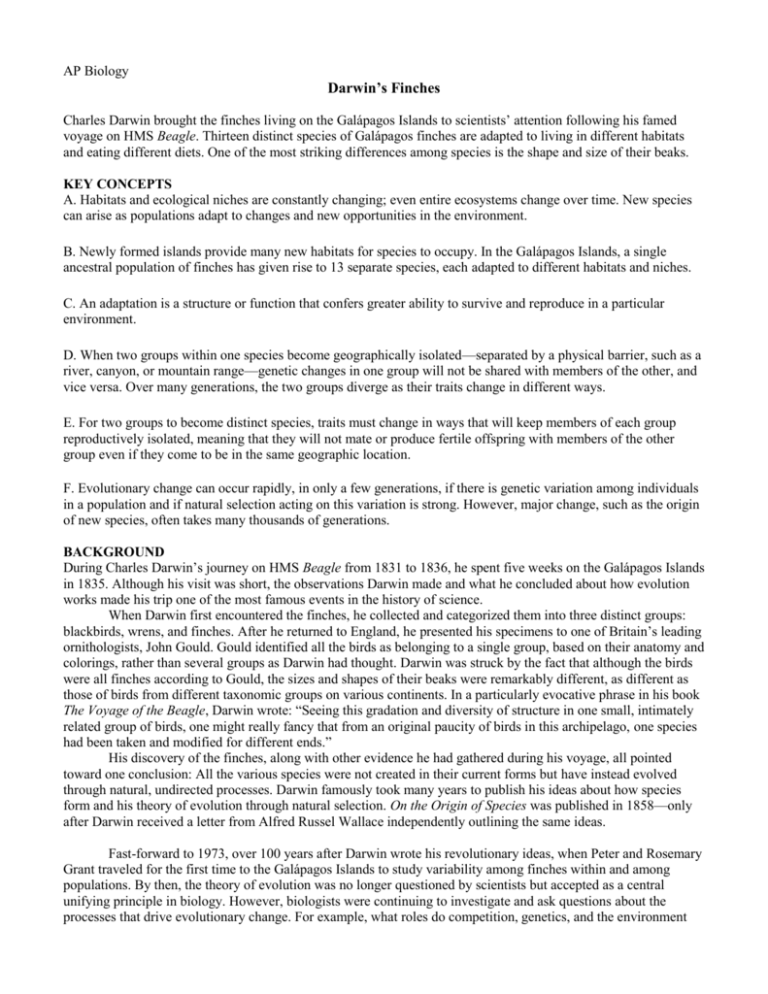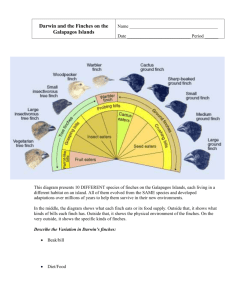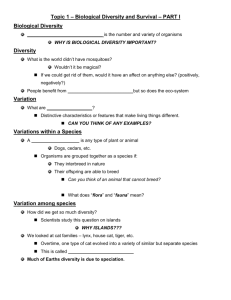AP Biology - Lincoln High School
advertisement

AP Biology Darwin’s Finches Charles Darwin brought the finches living on the Galápagos Islands to scientists’ attention following his famed voyage on HMS Beagle. Thirteen distinct species of Galápagos finches are adapted to living in different habitats and eating different diets. One of the most striking differences among species is the shape and size of their beaks. KEY CONCEPTS A. Habitats and ecological niches are constantly changing; even entire ecosystems change over time. New species can arise as populations adapt to changes and new opportunities in the environment. B. Newly formed islands provide many new habitats for species to occupy. In the Galápagos Islands, a single ancestral population of finches has given rise to 13 separate species, each adapted to different habitats and niches. C. An adaptation is a structure or function that confers greater ability to survive and reproduce in a particular environment. D. When two groups within one species become geographically isolated—separated by a physical barrier, such as a river, canyon, or mountain range—genetic changes in one group will not be shared with members of the other, and vice versa. Over many generations, the two groups diverge as their traits change in different ways. E. For two groups to become distinct species, traits must change in ways that will keep members of each group reproductively isolated, meaning that they will not mate or produce fertile offspring with members of the other group even if they come to be in the same geographic location. F. Evolutionary change can occur rapidly, in only a few generations, if there is genetic variation among individuals in a population and if natural selection acting on this variation is strong. However, major change, such as the origin of new species, often takes many thousands of generations. BACKGROUND During Charles Darwin’s journey on HMS Beagle from 1831 to 1836, he spent five weeks on the Galápagos Islands in 1835. Although his visit was short, the observations Darwin made and what he concluded about how evolution works made his trip one of the most famous events in the history of science. When Darwin first encountered the finches, he collected and categorized them into three distinct groups: blackbirds, wrens, and finches. After he returned to England, he presented his specimens to one of Britain’s leading ornithologists, John Gould. Gould identified all the birds as belonging to a single group, based on their anatomy and colorings, rather than several groups as Darwin had thought. Darwin was struck by the fact that although the birds were all finches according to Gould, the sizes and shapes of their beaks were remarkably different, as different as those of birds from different taxonomic groups on various continents. In a particularly evocative phrase in his book The Voyage of the Beagle, Darwin wrote: “Seeing this gradation and diversity of structure in one small, intimately related group of birds, one might really fancy that from an original paucity of birds in this archipelago, one species had been taken and modified for different ends.” His discovery of the finches, along with other evidence he had gathered during his voyage, all pointed toward one conclusion: All the various species were not created in their current forms but have instead evolved through natural, undirected processes. Darwin famously took many years to publish his ideas about how species form and his theory of evolution through natural selection. On the Origin of Species was published in 1858—only after Darwin received a letter from Alfred Russel Wallace independently outlining the same ideas. Fast-forward to 1973, over 100 years after Darwin wrote his revolutionary ideas, when Peter and Rosemary Grant traveled for the first time to the Galápagos Islands to study variability among finches within and among populations. By then, the theory of evolution was no longer questioned by scientists but accepted as a central unifying principle in biology. However, biologists were continuing to investigate and ask questions about the processes that drive evolutionary change. For example, what roles do competition, genetics, and the environment play? How do these factors work together to produce the variety of species in existence today as well as those we have discovered in the fossil record? Forty years of research on the Galápagos finches has helped provide some of the answers. Islands Are Natural Laboratories To gain insights on particular research questions, researchers generally try to limit the number of variables being considered. For that reason, studies in speciation often focus on groups of species that are closely related and living in relatively contained, isolated habitats, such as islands. The Grants’ studies of speciation have focused on the finches living on the Galápagos Islands. These islands sit on the equator in the Pacific Ocean 973 km west of Ecuador, South America. The distance between the mainland and the closest island in the Galápagos makes it unlikely for mainland species of plants or animals to colonize the islands. However, given enough time, some mainland species will make the journey. Flying animals like birds, bats, and insects can, on rare occasions, move from the mainland to ocean islands and from island to island, even if these are separated by large distances. This can happen, for example, when birds are blown off course by a storm. Flying animals can accidentally carry seeds with them—for example, in mud on their feet— which can germinate and grow to form their own populations. Large seeds, like coconuts, can float to the islands on their own and germinate there. The Galápagos Islands are not only remote but they are also geologically young. They are volcanic islands that began rising from the seafloor between 4 million and 5 million years ago. Some of the first islands to emerge are now back under water due to erosion and subsidence. The current islands have been above the ocean surface for about 3 million years or less. Thus, the species found on the Galápagos Islands today are relatively few and most have only existed there for less than 3 million years. Scientists can study how these species evolved in a relatively short period of time in a new environment that is largely undisturbed by human activities. In addition, on the smaller islands, like Daphne Major, scientists can potentially study entire populations of animals living on those islands for many generations. For all these reasons, islands can function like natural laboratories. Evolution of the Galápagos Finches When the Grants began their study, they didn’t know whether the Galápagos finches arose from a single species or from two or more that independently came to the islands. At one extreme, if each Galápagos species came separately from the mainland, then each of the 13 Galápagos species living on the islands today should be more closely related to a species on the mainland than to another Galápagos species. One way to study evolutionary relationships among species is to compare DNA sequences. When the Grants looked at genetic data from mainland birds and compared those to genetic data from the finches, they discovered that a single mainland species, the grassquit, is the closest living relative of all the finches. This discovery was not compatible with a multiple-origins hypothesis. The ancestral species to all of the finches on the Galápagos had likely been a seed-eating species like the grassquit that arrived on the islands around 2 million years ago. The first group of finches likely arrived on one of the Galápagos Islands and over time diversified into different species of birds. The original founding population has gone extinct and probably other species have as well. The 13 species that inhabit the islands today are the result of 2 million years of evolution. When the first ancestral population of finches arrived on the islands, many of the potential ecological niches were still available because the islands were young and there was little, if any, competition for resources. As different populations of finches occupied these niches, they evolved adaptations that enabled them to survive in the different habitats. Thus, in a relatively short time many different species of finches formed from a single ancestral population, a process called adaptive radiation. Today, 13 species of finches live on the islands of the Galápagos archipelago and an additional one on Cocos Island—an uninhabited island off the coast of Costa Rica located about 720 km north of the Galápagos Islands. This rapid radiation of finch species would not have occurred in an environment in which all the ecological niches were already occupied. When the founding population diverged into two descendants, one of the descendants evolved into the warbler finch and the other descendant gave rise to all the other finch species. The warbler finch is the only insecteating Galápagos finch that can catch insects while in flight. Thousands of years later, the finch population diverged and one descendent led to the vegetarian finch and the other to the ancestor of the remaining finch species. The vegetarian finch is aptly named because its diet is mainly made up of fruits, flower buds, and blossoms. The final two groups that later formed branches of their own on the Galápagos finch family tree are the insect-eating tree finches and the seed-eating ground finches, which also include the cactus finches. One trait which is highly diverse among the Galápagos finch species is the size and shape of the beak. For example, the cactus finch (Geospiza scandens) has a long, pointed beak capable of probing and opening cactus fruits to eat the seeds. It also eats the pollen and nectar of the cactus flowers. With its shorter, blunter beak, the medium ground finch (Geospiza fortis) can only eat cactus seeds once fruits fall to the ground or are opened by cactus finches. However, it can also crack open some larger and sturdier species of seeds that the cactus finch cannot open. Scientific Name English Name Geospiza fuliginosa Geospiza fortis Geospiza magnirostris Geospiza difficilis Geospiza scandens Geospiza conirostris Camarhynchus parvulus Camarhynchus pauper Camarhynchus psittacula Camarhynchus pallidus Camarhynchus heliobates Platyspiza crassirostris Certhidea olivacea Small ground finch Medium ground finch Large ground finch Sharp-beaked ground finch Cactus finch Large cactus finch Small tree finch Medium tree finch Large tree finch Woodpecker finch Mangrove finch Vegetarian finch Warbler finch Approximate weight (grams) 14 20 34 20 21 28 13 16 18 20 18 35 8 Most of the Grants’ research has focused on the medium ground finch and the cactus finch, both on the island of Daphne Major. By observing these birds year after year for four decades, they have shown that as the environment changes so too do the traits of the birds. When the island of Daphne Major experienced an extreme drought in 1977, food quickly became scarce. Medium ground finches have stout beaks that are ideal for picking up seeds from the ground, but there is great variation in beak sizes within medium ground finch populations. When seeds were plentiful, there were many different seed sizes and all the medium ground finches had enough to eat. But after the drought, the smaller, soft seeds from cactuses and other plants were eaten until hardly any remained. The smaller medium ground finches with smaller beaks ran out of food and began dying. Finches that were larger and had larger beaks could still forage on the larger, harder seeds of a plant called caltrop. These birds had a survival advantage, but even they struggled to handle these seeds that are covered in sharp spines. Around 1,200 medium ground finches were alive at the beginning of the drought, but fewer than 200 survived: a loss of 85%. Most of the survivors were larger and had larger beaks. (60% of the cactus finches on Daphne Major also died.) The larger-beaked medium ground finches that survived reproduced in the year after drought. The Grants discovered that the next year, the offspring of surviving medium ground finch individuals had beaks similar in size to those of their parents, showing that the beak size trait is strongly heritable. The average beak size of the birds in the new, post-drought population was 4% larger. Four percent is a big change in such a short time and is consistent with the interpretation that beak size is an inherited trait that has a strong influence on the survival of an individual finch. The Grants are among the few scientists to have directly witnessed and measured evolutionary changes taking place in real time. But how do changes like the ones they observed lead to new species? To begin to answer that question, an additional ingredient—reproductive isolation—must be considered. A broad definition of a species is a group of interbreeding individuals who are reproductively, and thus genetically, isolated from other groups. When populations of finches initially occupied different habitats on the same Galápagos Island, breeding among all the finches was likely common, allowing for genetic exchange among them. However, as populations became more isolated on different islands, breeding between members from two different populations became increasingly rare. The genetic changes responsible for changes in beak size and shape, in body size, and in feeding ecology became less likely to be shared among the different populations. These changes were also accompanied by changes in the songs the birds sing. The Grants have shown that enough differences in song and appearance will keep two finch species from interbreeding, and thus keep them genetically isolated from each other, even if they are living in the same general area. When the time comes to choose a mate, finches do so largely on the basis of appearance and song. Galápagos finches learn their species’ song during a very short sensitive period early in life, usually from their fathers, and retain that song for life. In the course of speciation, changes in song in a population provide a behavioral barrier to the exchange of genes with other populations. Once this barrier is in place, genetic differences can accumulate in different populations even if they are living in the same geographical location. Eventually these changes become so numerous that members of one population will not be able to produce fertile offspring with members of another population. They will have become distinct species. Current Galápagos finch species tend to keep to themselves, but some are still capable of exchanging genes. In rare instances, the Grants have shown that a cactus finch might mate with a medium ground finch on Daphne Major and produce fertile offspring. This might happen, for example, when a male finch learns the wrong song from a neighbor. Hybrids can survive and reproduce under some circumstances, specifically if there is a rich supply of intermediate-size seeds suitable for birds with intermediate-size beaks. Discussion Allopatric speciation takes place when two populations are completely geographically isolated from each other and no gene flow occurs between them. Genetic changes in one population are never shared with the other population. When the founding population of seed-eating birds arrived on the early forming Galápagos Islands, it was isolated from its mainland population. However, allopatric speciation does not explain the origin of all new species. For example, in parapatric speciation, there is occasional gene flow between two populations that have adjacent geographic ranges. Genes may still flow intermittently between populations of finches on nearby islands, but it is rare. In sympatric speciation, gene flow is common because the two populations live in the same geographic area but occupy different parts of the same habitat. When speciation occurs in sympatric populations, one or more traits that are responsible for interbreeding are selected against. Such traits may include ones that affect appearance, the ability to tolerate certain environmental extremes, or the timing of reproduction for the two populations (e.g., spring or summer). In the case of the Galápagos finches, most researchers think that species originally formed following geographic isolation (or in allopatry). They then remained distinct species primarily due to behavioral isolating mechanisms that kept members of different species separate if and when they came into contact. • The average beak depth of the medium ground finches increased by over 4% from the time the 1977 drought began until after it ended. This change is nearly undetectable to the human eye. However, a bird, who is already close to starving and whose only means to get food is to pick up seeds, maneuver them so they are positioned correctly, and crack them open, even a 4% larger beak may mean the difference between life and death. Imagine that your only route to survival is being able to pick up a basketball by palming it with one hand. Fingers that are 4% to 6% longer than average could be quite an advantage. Also, 4% is an average number. Individuals with beaks that are 1% smaller are at a small disadvantage, whereas those with beaks 8% or 10% smaller are a strong disadvantage. Survival is probabilistic; there is an extremely low probability of survival for birds with beaks that are 10% or more smaller than the average, to a high probability for birds with beak sizes near the average and even higher for those above average. • Do the changes in beak size described as a result of the drought provide an example of speciation? The medium ground finches that survived the drought and their offspring, which inherited larger beaks, are still all medium ground finches. These changes in beak size represent adaptations in response to natural selection. If changes like these occur over thousands of generations and for different traits, including traits involved in reproductive isolation, then populations might be on the path to becoming a new species. • It is important to understand that the frequency and tempo of speciation vary over evolutionary history. Generally, fewer new species evolve when environmental conditions are constant. Rapidly changing conditions and disruptive environmental events can spur more rapid speciation. The so-called Cambrian Explosion is an example of relatively fast and extravagant speciation of animals, as is the speciation that occurred after major extinction events associated with environmental change in the Mesozoic and Permian. The Galápagos finches are a good example of an adaptive radiation that occurred recently and during a relatively short time. The fact that adaptive changes have been directly observed by the Grants gives us insights into how natural selection can contribute to the process of speciation. • The Galápagos Islands make for an ideal place to study evolutionary processes like natural selection and adaptive radiation because they are geologically young, remote, and relatively undisturbed. Evidence of adaptive evolution can be found among other island species. For example, the honeycreepers of the Hawaiian Islands have evolved in much the same way as the Galápagos finches, but the Hawaiian Islands have been inhabited by humans for thousands of years and habitats have been altered extensively by human activities and by species introduced to the islands by humans. These factors make studying the honeycreepers more challenging than studying the finches of the Galápagos. • Are there examples of adaptive radiation beyond the Galápagos finches? Indeed, several other examples of adaptive radiation have been studied. The African cichlids are one of the most striking ones. The cichlids are a diverse group of freshwater fish, some of which live in lakes and rivers in western Africa. In the last 10 million years, the African cichlids have evolved into over 2,000 different species. Scientists have proposed three major stages in the adaptive radiation of the cichlids. In the first stage, cichlid species diverge in using very different habitats, just as tree and ground finches have diverged. In the second stage, just like the changes in beak shape among the finches, mouth shape diverges among the cichlid species adapting to eating different types of food. In the last stage, divergence occurs in signals used in species recognition, usually the color of the males. This sexual selection by female choice drives changes in the appearance of the fish. This last mechanism is similar to mate choice in the finches, which is dependent on the overall body shape of a potential mate and the song the male sings.







